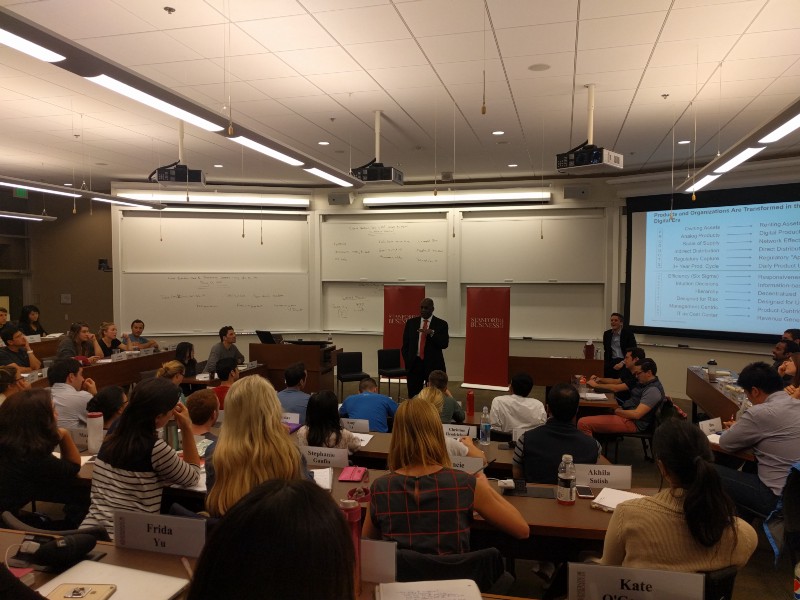Industrialist’s Dilemma — Session 5
This article was written by XSeed Capital Partner, Robert Siegel, and originally appeared on Medium.
This week the class transitioned from the “disruptors” to the “disruptees,” and gave us the opportunity to speak with our first guest on how his large industrial era firm is coping with the massive changes brought upon by new digital technologies and entrants.
Bernard Tyson, the CEO of Kaiser Permanente, kicked off the second half of the course, and his style, issues and perspectives were a jarring juxtaposition to what we had in our first four class sessions. For perspective, if Kaiser Permanente were a country, with ~$62B in annual revenues they would be approximately the world’s 70th largest country (about the size of Luxembourg, Kenya or the Dominican Republic). Given that $4 trillion a year is spent on healthcare in the United States, we began to understand the scope of the Industrialist’s issues — healthcare is 80x larger than the smartphone market in the US, and 8x larger than annual automobile and light truck sales in the US. The bottom line — this is an enormous scale and segment that is being completely upended by new companies, new technologies and new regulations.

Bernard Tyson talks about Kaiser Permanente and the US healthcare system
Bernard could not have been more open in his perspectives, the discussion of his challenges and his points-of-view on where things are headed.
If One Controls The Whole $1, One Thinks Differently…
Kaiser Permanente is unique to many medical service providers in that they “control the entire $1” for a patient — from hospital stay to ongoing wellness visits. This aligns incentives in ways that are not possible with most current healthcare providers and participants. Whereas most for-profit hospitals lose revenue when a patient checks out, Kaiser sees its hospitals as a cost center. What makes this mindset work is that when a patient is discharged, he/she goes to a Kaiser doctor for ongoing treatment. As such, the hospital does not have the incentive to do unnecessary tests or to increase stays since that drive up costs. But, by the same token, Kaiser also has an incentive to make sure patients are properly healed because not providing adequate care could likely bring a patient back in for more service (and thus increase costs without a corresponding increase in revenues).
Bernard Tyson shares his vision for Kaiser Permanente
This structure creates an incentive to think “wing-to-wing” in terms of healthcare, and to embrace new technologies that might improve the health of patients. If one is only a provider of part of a healthcare solution for a patient (e.g. only a hospital, only an insurance provider, only a doctor, etc.) behavior can be driven by economic incentives that do not maximize the overall health and cost effectiveness for the patient.
In addition, Kaiser has the unique position of being able to share data between portions of its business in ways that other providers are not able: from hospital visits to doctor’s exams to payments and costs. Kaiser sees trends and take actions on areas where no one else is able. In addition, they have the ability to pool individual data to help their larger customer population — a trend we also saw in the business model of Anne Wojcicki and the team at 23andMe. Even when managing issues of privacy and dealing with sensitive information, integrated incumbents (or even integrated upstarts) are able to use disparate pockets of data in combination that make life better for customers — in ways non-integrated providers cannot.
Legacy Can Get In The Way of Progress
In our class on Enjoy with Ron Johnson we talked about how hard it is for incumbents such as Best Buy to respond to new entrants due to the old compensation and employment systems with which they are burdened in responding to new business models. Bernard also shared how a recent IT upgrade at Kaiser Permanente cost $1 billion vs. a budgeted $500 million due to interface challenges with legacy systems.
This may be one of the greatest problems for incumbents — both the mindshare of management and dollars which are forced to support existing sedimentary layers of an organization so that the organization can continue to provide current products and services. Kaiser has attempted to deal with this in ways that several other giants have also addressed — by creating a corporate venture capital arm and looking for partnerships to respond more quickly to changing market needs. Bernard posited that Kaiser’s integrated approach actually necessitates his constantly looking for best practices and new technologies to be incorporated into their systems.
We believe that this will be an ongoing theme in the next four sessions — Industrialists are being forced to partner with outside firms in ways that they have not had to previously, which requires huge cultural mindset changes in all functions of their firms.
Healthcare Is Coming Home
One of our unexpected learnings was that whereas previously healthcare had been hospital-focused (single-channel), even an organization like Kaiser Permanente is thinking about omni-channel solutions to reach its customers. Bernard talked about the high number of eVisits that they are doing now with patients via smartphones, and how they are aggressively working to communicate with patients offsite in ways that are HIPAA-compliant.
Whereas Kaiser started as a hospital, it is no longer only a physical place — they are seeking to drive the notion that healthcare can be delivered anywhere at anytime in a way that creates a better experience for patients — and new technologies are a critical part in making that happen. And not all of those technologies will be developed internally — many will come from the outside.
